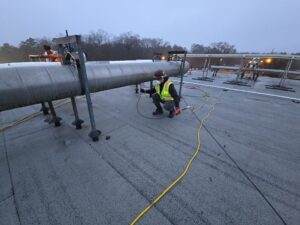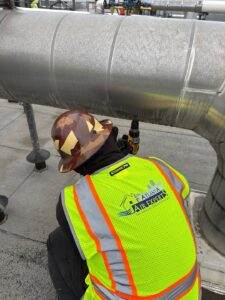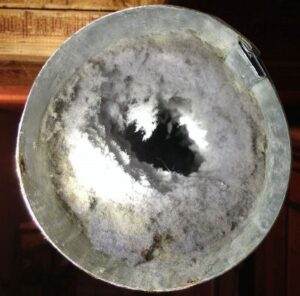Ever wondered why your energy bills keep going up? Or why some rooms in your home feel colder or warmer than others? It might not be your HVAC system’s fault. It could be the ductwork that carries air around your home.
Ductwork repair is key to making your home’s heating, ventilation, and air conditioning (HVAC) systems work better. When ductwork is in good shape, air flows smoothly. This keeps your home at a comfortable temperature and the air clean.
Leaky ducts make your HVAC system work too hard. This raises your energy bills. You might find that some rooms are not as warm or cool as others because of duct problems. If your ducts are noisy or you see cracks, it’s time to call a pro.
Keeping your ductwork in check can stop sudden jumps in energy costs. It also means you won’t have to spend a lot on repairs later. Fixing ductwork issues can save you money on bills and make your home more comfortable.
Key Takeaways
- Leaky ducts significantly impact HVAC efficiency and drive up energy costs.
- Uneven heating or cooling can indicate ductwork issues.
- Noisy ducts, such as whistling or banging sounds, suggest problems.
- Visible damage in ducts should be fixed right away to avoid energy loss.
- Fixing ductwork issues can improve HVAC efficiency and air quality.
- Regular ductwork maintenance can prevent expensive repairs later.
- A sealed duct system means lower energy bills and better comfort.
Understanding Ductwork Systems
It’s important to know how ductwork systems work to keep your home efficient and healthy. These systems help distribute air throughout your house. They are key for saving energy and keeping the air clean inside.
What is Ductwork?
Ductwork is the network of airways in your home’s HVAC system. It’s essential for good airflow. This ensures your system works well, like high-efficiency furnaces needing about 150 CFM of air for every 10,000 BTUs of heat.
Common Ductwork Materials
Ductwork is made from materials like galvanized steel, aluminum, and flexible plastic or fiberboard. Aluminum is light and doesn’t rust, while galvanized steel is strong for homes and businesses. Flexible ducts are easy to put in but might not last as long.
How Ductwork Functions in Your Home
Ductwork carries conditioned air from your HVAC system to different rooms. It’s vital to have well-designed and maintained ducts for efficient airflow. For example, heat pumps need about 400 CFM of air for every ton of cooling or heating.
Regular checks and cleanings every five years help avoid problems. This keeps your ductwork running smoothly, making your home comfortable and energy-efficient.
Signs Your Ductwork Needs Repair
Spotting ductwork problems early can save you money and time. Knowing the signs helps you figure out if you need a full replacement or just a fix. Here are the key things to watch for:
Reduced Airflow in Certain Rooms
Notice some rooms get less air? This might mean blockages or leaks. The U.S. Department of Energy says up to 30% of HVAC energy loss comes from bad ductwork. A pro ductwork contractor can find and fix these problems, ensuring air flows well everywhere.
Increased Energy Bills
Seen your energy bills go up without using more? This could mean 20% or more of duct air is lost, making your HVAC work harder. Old homes with bad ducts can see bills rise 10-30%. Fixing leaks or blockages can cut costs and boost system efficiency.
Unusual Noises from Ducts
Heard rattling or banging from your ducts? It means something’s wrong. These sounds usually point to loose parts or damage. Ignoring these can lead to bigger problems and higher repair costs, up to 20%. Getting a ductwork contractor to check it out early can stop these issues from getting worse.
Musty or Unpleasant Odors
Smell musty or bad when your HVAC runs? It might mean mold or mildew in your ducts. Mold in ducts can harm your health, affecting about 15% of people. It’s important to fix this fast to keep air clean and avoid health risks.
Benefits of Ductwork Repair
Investing in professional ductwork repair can greatly improve your HVAC system’s performance. It enhances air quality and energy efficiency. These improvements can make your home more comfortable and lower your utility bills.
Improved Air Quality
Professional ductwork repair is key to improving air quality in your home. Sealing leaks and cracks keeps dust and allergens out. This can cut allergen levels by up to 50%.
Clean ducts mean fewer airborne particles, making your home healthier. They also reduce allergy symptoms by 25%.
Enhanced Energy Efficiency
Professional ductwork repair boosts energy efficiency. Fixing air leaks and blockages improves airflow by 20% to 30%. This means your HVAC system works less hard, saving you 20% to 40% on electricity bills.
Inefficient ductwork can use up to 30% of your home’s energy. Repairs can save you money and make your home more efficient.
Longer Lifespan of HVAC Systems
Regular ductwork maintenance and repairs also extend your HVAC system’s life. Well-kept ducts mean fewer expensive repairs, keeping your system running smoothly. This can add years to your HVAC system’s life.
Companies like Champion Home Services, with over 40 years of experience, say energy-efficient systems last longer. They work better and need less frequent replacements.
Professional ductwork repair is a wise investment. It improves air quality, energy efficiency, and lifespan of your HVAC systems. It’s a step towards better comfort, lower bills, and a healthier home.
The Ductwork Repair Process
Do you have uneven temperatures or higher energy bills at home? It might be time for a ductwork check. Leaky ducts can waste up to 30% of the heating and cooling energy used by HVAC systems, says the EPA. So, fixing ductwork quickly is key to keeping your HVAC system running well.
Initial Inspection and Assessment
The first step is a detailed ductwork inspection to find any problems. This includes tests like duct pressure testing and infrared camera checks to find leaks or areas needing work. Finding these issues early saves time and money, making your system work better.
Recommended Repair Solutions
After finding the damage, experts suggest fixes that fit your needs. Often, fixing air leaks with mastic sealant is needed. Sometimes, duct sections must be replaced if they’re badly damaged. Sealing ducts not only boosts system efficiency but also keeps pollutants out of the ductwork.
Air Sealing Techniques
Using the right air sealing methods is key to stopping leaks. For example, Aeroseal works well for small holes, improving system performance. Mastic sealant with fiberglass mesh tape seals bigger gaps better. Most experts say up to 70% of the time, it’s better to repair old ductwork than replace it.
Cleaning and Maintenance
Keeping your ductwork clean and maintained is important. Cleaning vents can cut energy costs by 10-15% by stopping dust and debris buildup. Regular upkeep also makes your HVAC system last longer, saving you money by up to 50%. Keeping your ductwork in top shape improves your home’s comfort and energy use.
DIY vs. Professional Repair
Deciding whether to fix ductwork yourself or hire a pro can be tough. Both choices have good and bad sides. Knowing when to DIY and when to call an expert can save you money, time, and stress.
When to DIY?
Small ductwork fixes, like sealing leaks, are good DIY projects. They need simple tools and can quickly improve your HVAC’s performance. Doing it yourself can cut down on labor costs, saving you money.
Reasons to Hire a Professional
For big problems like major leaks or damage, get a pro. They have the right tools and know-how to fix issues fast. They use special gear to ensure the job is done right the first time.
Professional ductwork services also include detailed checks and upkeep. This boosts your indoor air quality and energy use. Hiring experts means your repair will be done well and last longer.
Cost Considerations
Professional ductwork repair costs vary, but it’s often worth it in the long run. Unlike DIY, which can lead to expensive errors, pros offer warranties and guarantees. This gives you peace of mind.
Understanding the total cost of ductwork, including long-term savings, helps you decide. Weighing the pros and cons of each option is key to keeping your ductwork in top shape.
Common Ductwork Issues
Keeping your HVAC system in top shape means spotting and fixing common ductwork problems. Issues like air leaks and insulation issues can really hurt your home’s energy use and air quality. Knowing about these problems can make a big difference.
Leaks and Holes
Many homeowners don’t know how common duct leaks and holes are. If your ducts aren’t sealed well, your HVAC system has to work much harder. This can make your energy bills go up.
It’s estimated that up to 30% of air in duct systems can leak out. Fixing these leaks with ductwork replacement or HVAC duct repair can save you money and energy.
Misalignment of Ducts
Ducts that aren’t aligned right can mess up airflow and make some areas of your home too hot or cold. This can also make your HVAC system work harder and use more energy. Keeping your ducts in line through regular ductwork maintenance is key.
About half of homes have blocked or damaged supply vents. This can really affect how well your home feels. Getting your ducts aligned right can make your home more comfortable and efficient.
Insulation Problems
Insulation issues are common, like in attics. If your ducts aren’t well-insulated, you could lose up to 20% of your heating and cooling. Also, if your insulation looks loose or stained, it might be leaking.
Fixing these problems with ductwork replacement or repair is important. Adding insulation to exposed ducts can help a lot. It can make your system more efficient and cut down on energy costs.
Tools and Materials for Ductwork Repair
When fixing ductwork, having the right tools and materials is key. You’ll need everything from basic hand tools to safety gear. Each item is important for fixing your HVAC system.
Essential Hand Tools
Basic tools like screwdrivers, pliers, and a flashlight are a must. They help you check and fix your ductwork. A tube cutter is also important for making clean cuts and avoiding leaks.
Using a multimeter can help fix electrical problems fast. This can make your system work better.
For more on essential tools, check out ATL Duct Cleaning.
Sealants and Insulation Materials
Sealants like mastic tape or foil tape are key for fixing leaks. About 25% of conditioned air is lost to leaks. Good sealants can cut this loss by 20%.
Insulation materials like fiberglass or foam boards keep air temperature right. This makes your HVAC system work better.
Safety Equipment
Your safety is the most important thing when fixing ductwork. Wear gloves, masks, and goggles to protect yourself. These items cost between $10 and $30 each.
Protective gear keeps you safe and lets you focus on the repair. For good air duct maintenance, check out OK Duct Cleaning.
How to Maintain Your Ductwork
Keeping your ductwork in good shape is key for efficient heating and cooling. Regular ductwork inspection, cleaning, and professional care can make your HVAC system last longer and work better. Here are some important tips for maintenance.
Regular Inspections
Make sure to have ductwork inspections done at least once a year. These checks help spot problems like leaks or blockages that waste energy. A home can lose 10% to 30% of its heated or cooled air due to duct leaks.
Cleaning Frequency Recommendations
Following the right cleaning schedule is important to reduce pollutants and allergens. Cleaning regularly can cut indoor air pollutants by 50% on average. Also, changing or cleaning air filters often is necessary to avoid a 15-20% drop in airflow.
Scheduling Professional Maintenance
While you can do some tasks yourself, professional maintenance by a skilled ductwork contractor is essential. Getting professional maintenance every few years ensures your ducts are clean and sealed. This can save you 20-30% on energy costs. Plus, professional insulation of ducts can cut energy costs by up to 20%.
By following these steps, you can keep your air flowing well, improve air quality, and extend your HVAC system’s life. Remember, a well-kept ductwork system is vital for a cozy and energy-saving home.
Choosing a Ductwork Repair Service
Finding the right ductwork contractor is key to a better home. They should be licensed and insured, meeting all standards. Look for contractors with good references and reviews. For example, Sandium Heating & Air Conditioning has a 4.9 out of 5 rating from 127 reviews, showing their trustworthiness.
What to Look for in a Contractor
Experience is vital when picking a contractor for professional ductwork repair. They should be able to fix many problems, from small leaks to full replacements. Also, they should use top-quality materials and the latest technology for better ductwork.
Questions to Ask Before Hiring
Ask contractors about their experience with problems like yours. Find out their process, how long repairs take, and if they offer maintenance or inspections. This helps you choose wisely and ensures the work is up to your standards.






